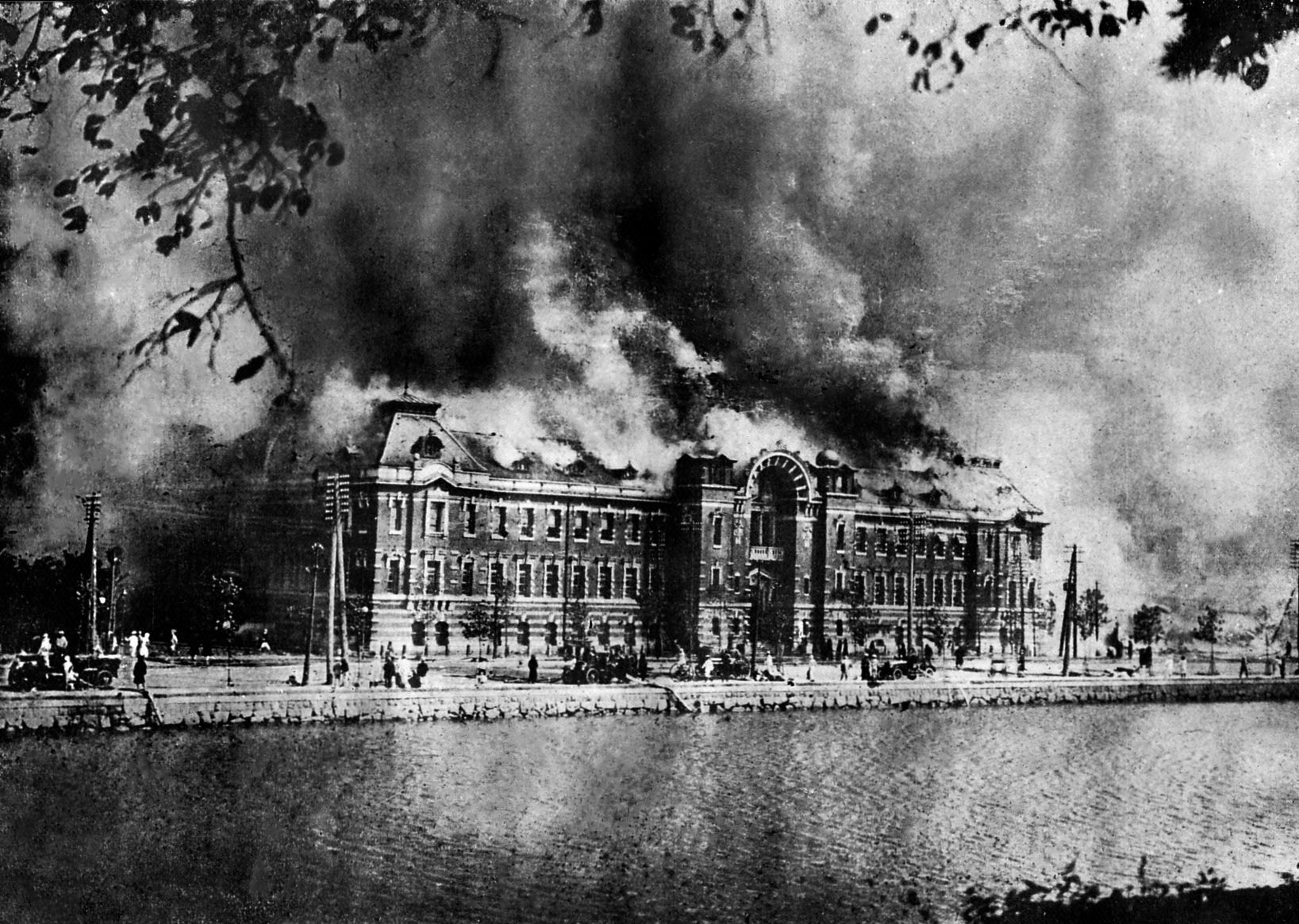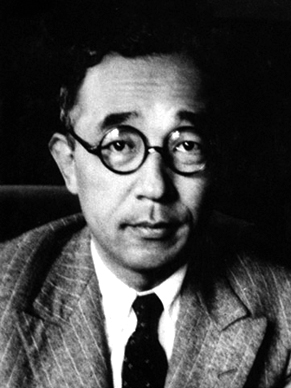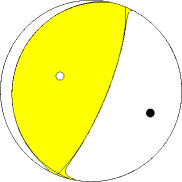|
Jōban Line
The is a railway line in Japan operated by the East Japan Railway Company (JR East). The line officially begins at Nippori Station in Arakawa, Tokyo before the line officially ends at Iwanuma Station in Iwanuma, Miyagi. However, following the opening of the Ueno–Tokyo Line, Jōban Line train services originate at or ; likewise, Jōban Line trains continue past Iwanuma onto the Tōhoku Main Line tracks to . The line approximately parallels the Pacific coasts of Chiba, Ibaraki, and Fukushima Prefectures. The name "Jōban" is derived from the names of the former provinces of Hitachi (), and Iwaki (), which are connected by the line to reach Tokyo. The section of the Jōban Line between and , which extends through the exclusion zone surrounding the Fukushima Daiichi nuclear meltdown, closed in the wake of the 2011 Tōhoku earthquake and tsunami and Fukushima Daiichi nuclear disaster. After some major repairs, the section reopened on 14 March 2020 after 9 years without ... [...More Info...] [...Related Items...] OR: [Wikipedia] [Google] [Baidu] |
Tokyo
Tokyo, officially the Tokyo Metropolis, is the capital of Japan, capital and List of cities in Japan, most populous city in Japan. With a population of over 14 million in the city proper in 2023, it is List of largest cities, one of the most populous urban areas in the world. The Greater Tokyo Area, which includes Tokyo and parts of six neighboring Prefectures of Japan, prefectures, is the most populous metropolitan area in the world, with 41 million residents . Lying at the head of Tokyo Bay, Tokyo is part of the Kantō region, on the central coast of Honshu, Japan's largest island. It is Japan's economic center and the seat of the Government of Japan, Japanese government and the Emperor of Japan. The Tokyo Metropolitan Government administers Tokyo's central Special wards of Tokyo, 23 special wards, which formerly made up Tokyo City; various commuter towns and suburbs in Western Tokyo, its western area; and two outlying island chains, the Tokyo Islands. Although most of the w ... [...More Info...] [...Related Items...] OR: [Wikipedia] [Google] [Baidu] |
Ueno–Tokyo Line
The Ueno–Tokyo Line (), formerly known as the Tōhoku Through Line () is a railway line in Tokyo, Japan, operated by the East Japan Railway Company (JR East), linking Ueno Station and Tokyo Station, extending the services of the Utsunomiya Line, the Takasaki Line, and the Jōban Line southward and onto the Tōkaidō Main LineJR East Annual Report 2010 retrieved 2013-12-09 and vice versa. While on official maps the line is purple, rolling stock and signage show the line as orange stacked on green to reflect the through-running nature of services on these respective lines. The project began in May 2008 and was opened with the 14 March 2015 timetable revision, costing about JPY 40 billion. Direct ... [...More Info...] [...Related Items...] OR: [Wikipedia] [Google] [Baidu] |
651 Series
Year 651 ( DCLI) was a common year starting on Saturday of the Julian calendar. The denomination 651 for this year has been used since the early medieval period, when the Anno Domini calendar era became the prevalent method in Europe for naming years. Events By place Europe * King Clovis II of Neustria and Burgundy marries Balthild, said to be an Anglo-Saxon aristocrat sold into slavery in Gaul. She has been owned by Clovis' mayor of the palace, Erchinoald, who gives her to him to garner royal favour (approximate date). Britain * King Oswiu of Bernicia declares war on his rival, King Oswine of Deira. Oswine refuses to engage him in battle, and retreats to Gilling (North Yorkshire). Oswine is betrayed by a friend, and murdered by Oswiu's soldiers. * Œthelwald succeeds his uncle Oswine as king of Deira, and allies himself with Oswiu's enemy, King Penda of Mercia. Queen Eanflæd of Bernicia donates the estate of Gilling for the foundation of a monastery. Persi ... [...More Info...] [...Related Items...] OR: [Wikipedia] [Google] [Baidu] |
203 Series
The is an electric multiple unit (EMU) train type operated in Japan between 1982 and 2011 by Japanese National Railways (JNR) and later by East Japan Railway Company (JR East), and currently operated by KAI Commuter and Philippine National Railways. Formation The sets were formed as follows. Cars 3, 6, and 9 were each fitted with one PS21 Pantograph (rail), pantograph. Interior File:JNR203-interior.JPG, Interior view in September 2007 File:203 priority seating Yoyogi-Uehara 20101106.JPG, Priority seating in November 2010 History and operations The 203 series sets were made to replace the 103 series#103-1000 series, 103-1000 series EMUs in 1982. The 203 series EMUs were on through services between the Joban Line and Tokyo Metro Chiyoda Line. Withdrawal The trains were gradually replaced by new E233-2000 series EMUs, and the last set ran in revenue service on 26 September 2011. Overseas operations Indonesia Five former 203 series ten-car sets (Set numbers 51, 52, 66, 68, ... [...More Info...] [...Related Items...] OR: [Wikipedia] [Google] [Baidu] |
Tokyo Metro Chiyoda Line
The is a subway line owned and operated by Tokyo Metro in Tokyo, Japan. On average, the line carries 1,447,730 passengers daily (2017), the second highest of the Tokyo Metro network, behind the Tozai Line (1,642,378).Tokyo Metro station ridership in 2010 ''Train Media (sourced from Tokyo Metro)'' Retrieved July 23, 2018. The line was named after the Chiyoda ward, under which it passes. On maps, diagrams and signboards, the line is shown using the color green, and its stations are given numbers using the letter "C". Overview The line serves the wards of[...More Info...] [...Related Items...] OR: [Wikipedia] [Google] [Baidu] |
Hitachi (Japanese Train)
is a limited express train service operated in Japan by East Japan Railway Company (JR East) on the Jōban Line between Shinagawa Station / Ueno Station in Tokyo and Sendai Station (Miyagi), Sendai Station in Miyagi Prefecture. The ''Tokiwa (train), Tokiwa'' service follows the same route but makes additional stops. History The name was taken from the former Hitachi Province (常陸), which is now part of the Ibaraki Prefecture. The service was first introduced on 1 October 1963 for a semi-express service which operated daily between Ueno and Taira (present-day Iwaki) using 451 series EMU stock, will all cars reserved. This service operated until 30 September 1967. The name was subsequently reintroduced on 1 October 1969 for a once-daily seasonal limited-express service operating between Ueno and Iwaki using 7-car KiHa 81 series diesel multiple units. This became a regular daily service the following year. 485 series EMUs were phased in from 2 October 1972, and were used un ... [...More Info...] [...Related Items...] OR: [Wikipedia] [Google] [Baidu] |
Mikawashima Train Crash
The was a multiple train crash which occurred on 3 May 1962 near Mikawashima Station in Arakawa, Tokyo, Japan. It involved a freight train and two passenger trains; 160 people were killed. As of 2024, the crash remains the third-deadliest in Japanese history, surpassed only by the Tsurumi rail accident and the Hachikō Line derailment. First train At 21:36, a Mito-bound freight train (No. 287) was approaching to join the main Jōban Line at Mikawashima Station and missed the red signal. A fail-safe mechanism diverted the freight train onto a safety siding, preventing a devastating head-on collision, however the freight train was travelling too fast and derailed in the siding, leaving the JNR Class D51 locomotive, and leading tanker-wagon obstructing the main line.''The Japan Times'', "102 dead in triple Tokyo train crash", 4 May 1962 (reprinted in ''The Japan Times'', 20 May 2012, p. 8) Second train A seven-carriage passenger train (2117H) bound for from left Mikawashima ... [...More Info...] [...Related Items...] OR: [Wikipedia] [Google] [Baidu] |
Hatsukari
The and were limited express train services in Japan operated by Japanese National Railways (JNR) and later East Japan Railway Company (JR East) from 1958 until 2002. History The ''Hatsukari'' was first introduced on 1 October 1958 as a long-distance steam-hauled limited express service operating between in Tokyo and via the Jōban Line. From 1960, new KiHa 81 series diesel multiple units were introduced on the service, reducing the journey time to 10 hours 25 minutes. From 1 October 1968, the train was amended via the more direct Tōhoku Main Line using 583 series electric multiple units. From 15 November 1982, with the opening of the Tōhoku Shinkansen to , the ''Hatsukari'' service was shortened to operate between Morioka and Aomori. This was extended to operate to in Hokkaido from 13 March 1988, following the opening of the undersea Seikan Tunnel. The maximum speed was raised to through the Seikan Tunnel from 16 March 1991. New E751 series electric multiple units wer ... [...More Info...] [...Related Items...] OR: [Wikipedia] [Google] [Baidu] |
Shimoyama Incident
The was the disappearance and death of Sadanori Shimoyama, the first president of Japanese National Railways, in Tokyo on 5 July 1949. Shimoyama disappeared on his way to work and his body was discovered on the Jōban Line in Adachi, Tokyo, Adachi the next day. The media offered conflicting explanations involving suicide and murder, while the police did not publicly report the results of their investigation, which was then ended. The Shimoyama incident, the Mitaka incident, and the Matsukawa derailment occurred within two months of one another, and together are known as JNR's Three Big Mysteries. Background was a bureaucrat of the Ministry of Land, Infrastructure, Transport and Tourism (Japan), Ministry of Transport, the successor to the Ministry of Railways (Japan), Ministry of Railways which had operated Japan's railway network. Shimoyama was appointed the first president of Japanese National Railways (JNR) when it was established on 1 June 1949. Under the Dodge Line policy ... [...More Info...] [...Related Items...] OR: [Wikipedia] [Google] [Baidu] |
Fukushima Daiichi Nuclear Disaster
The Fukushima nuclear accident was a major nuclear accident at the Fukushima Daiichi Nuclear Power Plant in Ōkuma, Fukushima, Japan, which began on 11 March 2011. The cause of the accident was the 2011 Tōhoku earthquake and tsunami, which resulted in electrical grid failure and damaged nearly all of the power plant's Emergency power system, backup energy sources. The subsequent inability to sufficiently cool reactors after shutdown compromised Primary containment, containment and resulted in the release of radioactive contamination, radioactive contaminants into the surrounding environment. The accident was rated seven (the maximum severity) on the International Nuclear Event Scale by Nuclear and Industrial Safety Agency, following a report by the JNES (Japan Nuclear Energy Safety Organization). It is regarded as the worst nuclear incident since the Chernobyl disaster in 1986, which was also rated a seven on the International Nuclear Event Scale. According to the United Nati ... [...More Info...] [...Related Items...] OR: [Wikipedia] [Google] [Baidu] |
2011 Tōhoku Earthquake And Tsunami
On 11 March 2011, at 14:46:24 Japan Standard Time, JST (05:46:24 UTC), a 9.0–9.1 Submarine earthquake, undersea megathrust earthquake occurred in the Pacific Ocean, east of the Oshika Peninsula of the Tōhoku region. It lasted approximately six minutes and caused a tsunami. It is sometimes known in Japan as the , among other names. The disaster is often referred to by its numerical date, 3.11 (read in Japanese). It was the List of earthquakes in Japan, most powerful earthquake ever recorded in Japan, and the Largest earthquakes by magnitude#Strongest earthquakes by magnitude, fourth most powerful earthquake recorded in the world since modern seismography began in 1900. The earthquake triggered powerful tsunami waves that may have reached heights of up to in Miyako, Iwate, Miyako in Tōhoku's Iwate Prefecture,Yomiuri Shimbun evening edition 2-11-04-15 page 15, nearby Aneyoshi fishery port (姉吉漁港)(Google map E39 31 57.8, N 142 3 7.6) 2011-04-15大震災の津� ... [...More Info...] [...Related Items...] OR: [Wikipedia] [Google] [Baidu] |
Iwaki Province (1868)
Map of the former Japanese provinces with Iwaki highlighted was an old province in the area that is today Fukushima Prefecture. Nussbaum, Louis-Frédéric. (2005). "''Iwaki''" in . It was sometimes called . History * This iteration of Iwaki Province was established during the Meiji Era. It was cut out of Mutsu Province and corresponded to the eastern part of what is now modern Fukushima Prefecture on December 17 of 1868 of Japanese calendar, which is January 19, 1869 of Gregorian calendar. Its population in 1872 was 348,608. Historical districts Iwaki Province consisted of fourteen districts: * Miyagi Prefecture ** Igu District (伊具郡) ** Katta District (刈田郡) ** Watari District (亘理郡) * Fukushima Prefecture ** Nakadōri Region, Fukushima *** Ishikawa District (石川郡) *** Shirakawa District (白川郡, a.k.a. Higashishirakawa or East Shirakawa) *** Shirakawa District (白河郡, a.k.a. Nishishirakwa or West Shirakawa) *** Tamura District (田村郡) ... [...More Info...] [...Related Items...] OR: [Wikipedia] [Google] [Baidu] |



